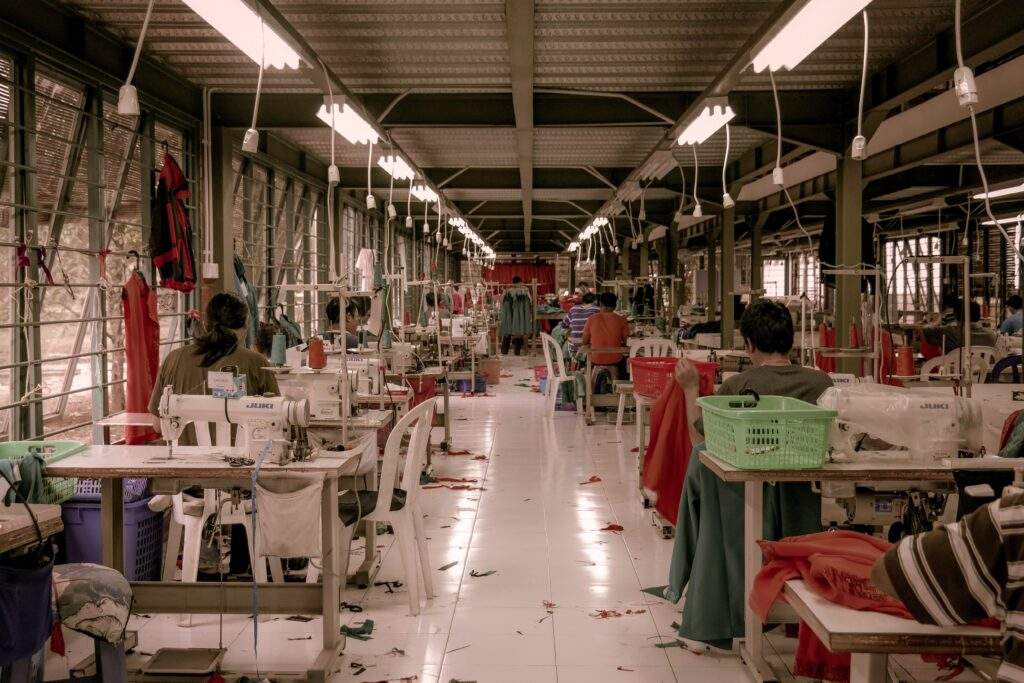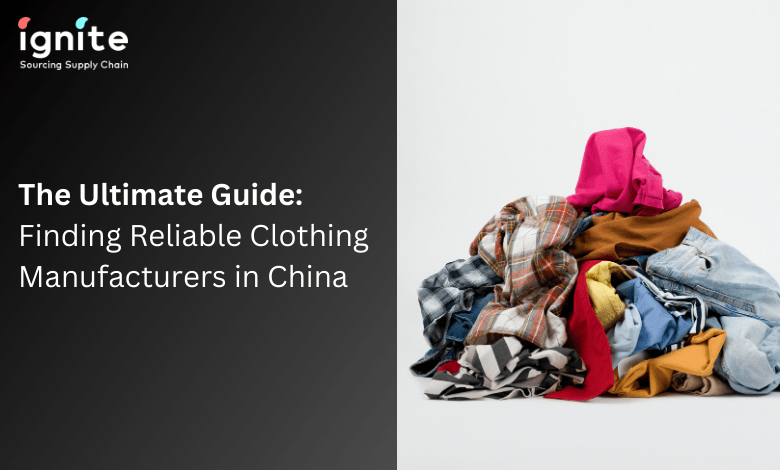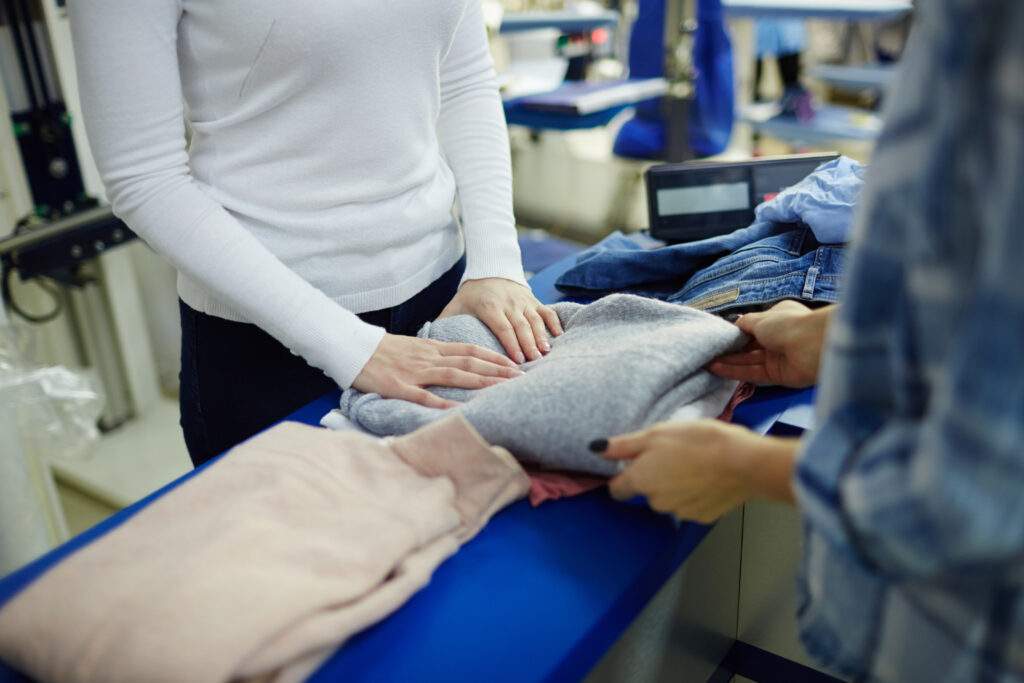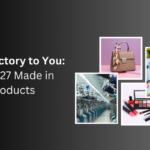A Comprehensive Analysis and Manufacturer Search in China
Welcome to our comprehensive guide on finding China clothing manufacturers and gaining valuable insights into the dynamic garment industry in China. As one of the largest exporters of clothing and textiles, China has established itself as a powerhouse in the global fashion market. Whether you are an aspiring fashion entrepreneur, a growing apparel brand, or a savvy business owner seeking high-quality manufacturing solutions, understanding the intricacies of the Chinese garment industry is essential.
In this blog, we will take you through the labyrinth of China’s clothing manufacturing landscape, providing you with invaluable tips, strategies, and resources to connect with reliable and reputable manufacturers. We will delve deep into the analysis of the garment industry in China, exploring its trends, opportunities, challenges, and the key factors that make it a preferred destination for businesses worldwide.
Finding a clothing manufacturer in China can be daunting, especially given the numerous options available. We will guide you through the process, sharing effective methods and techniques to identify trustworthy manufacturers who meet your specific needs, whether sourcing high-quality materials, achieving cost-effectiveness, or ensuring ethical and sustainable practices.
Furthermore, our analysis of the garment industry in China will shed light on the various aspects that contribute to its prominence. From understanding manufacturing capabilities, production capacities, and supply chain infrastructure to exploring the latest fashion trends, market dynamics, and regulatory frameworks, we aim to equip you with a comprehensive understanding of this thriving industry.
Join us as we unlock the secrets of finding China clothing manufacturers and provide you with valuable insights into the garment industry in China. Prepare to embark on a journey that will empower you to navigate this vast market, establish fruitful partnerships, and make informed decisions to drive your fashion business forward. Let us dive in and uncover the opportunities that await in Chinese garment manufacturing.
-
Analysis of China’s Garment Industry

The garment industry in China has emerged as a global powerhouse, playing a pivotal role in the fashion landscape. With its massive manufacturing capabilities, vast supply chain networks, and competitive pricing, China has become a preferred destination for businesses seeking clothing production at scale. We will explore the key factors contributing to China’s dominance in the garment industry and provide insights into its current state.
China’s garment industry boasts a rich history, with decades of experience and expertise in clothing manufacturing. Its ability to handle large-scale production efficiently has attracted numerous international brands and retailers looking to optimize their supply chains and achieve cost-effectiveness. Their well-established infrastructure, including its extensive network of factories, skilled labor force, and robust logistics systems, further reinforces its position as a global manufacturing hub.
One of the notable advantages of the Chinese garment industry is its vertical integration. Many manufacturers in China have in-house capabilities for designing, fabric sourcing, production, and quality control. This integrated approach allows for streamlined processes, shorter lead times, and enhanced control over product quality. Additionally, access to a wide range of raw materials, including textiles, fibers, and trims, enables manufacturers to cater to diverse product requirements and specifications.
Furthermore, China’s garment industry benefits from economies of scale, enabling manufacturers to offer competitive pricing without compromising quality. This cost advantage has made it attractive for businesses of all sizes, from large corporations to small and medium-sized enterprises, to leverage China’s manufacturing capabilities to meet their production needs.
In recent years, the garment industry in China has undergone significant transformations. Rising labor costs, changing consumer preferences, and increasing awareness about sustainability have influenced the industry’s dynamics. Chinese manufacturers have responded by investing in automation, adopting sustainable practices, and diversifying their product offerings to align with evolving market demands.
Moreover, China remains at the forefront of fashion trends, with its fashion weeks, trade shows, and design institutes fostering creativity and innovation. The country has witnessed the growth of domestic brands that have gained international recognition, demonstrating its ability to adapt and create fashion-forward designs.
However, note that the Chinese garment industry also faces challenges. Intellectual property concerns, supply chain complexities, trade policies, and regulation fluctuations pose risks for businesses operating in this market. Companies must conduct thorough due diligence and establish strong partnerships with reputable manufacturers to mitigate these challenges.
-
Where to Find China Clothing Manufacturers?
When it comes to finding China clothing manufacturers, there are several avenues you can explore.
Online B2B platforms: Websites such as Alibaba, Global Sources, and Made-in-China are widely used platforms that connect buyers with manufacturers from China. These platforms allow you to search for clothing manufacturers, browse their profiles, view product catalogs, and communicate directly with potential suppliers.
Trade shows and exhibitions: Attending trade shows related to the garment industry is an excellent way to meet Chinese manufacturers face-to-face. Events like the Canton Fair, China International Fashion Fair (CHIC), and Intertextile Shanghai Apparel Fabrics provide opportunities to network, establish contacts, and explore various clothing manufacturers in one location.
Sourcing agents and companies specialize in connecting businesses with suitable manufacturers. They have local expertise and established networks in China, which can help streamline the sourcing process and ensure reliable partnerships. Working with a reputable sourcing agent can save you time and provide valuable guidance.
Industry directories and databases: Online directories and databases specifically focused on the garment industry in China can be valuable resources. These platforms provide a comprehensive list and their contact details and product information. Examples include the Clothing Manufacturers Directory and China Textile & Apparel Directory.
Referrals and recommendations from industry peers, business networks, or trade associations with experience working with Chinese clothing manufacturers help. Word-of-mouth referrals can provide insights into reliability, quality, and professionalism, giving you a head start in your search.
Local Chambers of Commerce: Contact your local chambers of commerce or business associations with connections with China. They may have resources, contacts, or business matching services to help you find suitable clothing manufacturers.
| Clothes Category | Main Industrial Cluster Distribution | Prominent Manufacturing City |
| Men’s Apparel | Zengcheng; Guangzhou; Hangzhou | Guangzhou |
| Women’s Apparel | Guangzhou; Humen; Hangzhou | Humen |
| Children’s Apparel | Guangzhou; Hangzhou; Changshu | Changshu |
| Wedding Apparel | Suzhou; Xiangcheng; Jinchang | Xiangcheng |
| Underwear | Hangzhou; Foshan; Nanhai | Foshan |
| Shirt | Puning; Yiwu; Shaoxing | Shaoxing |
| Leather Apparel | Haining; Xinji | Haining |
| Cowboy Wear | Xintang; Changzhou; Zhongshan | Xintang |
| Woolen Sweater | Dongguan; Tongxiang | Dongguan |
| Down Coat | Gaoyou; Changshu; Hangzhou | Gaoyou |
| Trousers | Quanzhou; Shishi; Guangzhou | Quanzhou |
| Sportswear | Shishi; Xiamen; Guangzhou | Shishi |
| Swimsuit | Jinjiang; Xingcheng; Yiwu | Jinjiang |
| Replica Clothing | Guangzhou; Humen; Dongguan; Putian | Putian |
-
How to Customize Clothing with China Manufacturers?
Customizing clothing with China manufacturers can be an effective way to bring your unique designs to life.
Define your requirements: Clearly articulate your customization needs. Determine the type of clothing you want to customize, specific design features, materials, colors, sizes, and any additional details. The more precise and detailed your requirements, the better manufacturers can understand and meet your expectations.
Research and select manufacturers: Conduct thorough research to find China manufacturers specializing in the type of clothing you want to customize. Consider their expertise, experience, production capacity, quality standards, and ability to handle customization projects. Online platforms, industry directories, trade shows, and referrals can help you identify potential manufacturers.
Reach out to manufacturers: Contact selected manufacturers and express your interest in customizing clothing. Send a detailed description of your customization requirements, including design sketches, measurements, fabric preferences, and any specific embellishments or branding elements you desire. Request samples of their previous work or ask for fabric swatches to assess their quality and craftsmanship.
Communicate and collaborate effectively. Tell your needs, ask questions, and seek clarifications to ensure mutual understanding. Take regular updates throughout the production. Maintain open lines of communication to address any concerns or modifications.
Prototype development: Manufacturers will typically create a prototype based on your specifications. Evaluate the prototype carefully, considering fit, fabric quality, stitching, and overall design accuracy. Provide detailed feedback and collaborate with the manufacturer to refine the prototype until you are satisfied with the final result.
Finalize pricing and terms: Discuss pricing, minimum order quantities (MOQs), and production timelines. Ensure you understand the costs, including
customization fees, sampling charges, and shipping expenses. Agree upon payment terms, production schedules, and quality control measures to protect your interests.
Production and quality control: Once all details are ready, the manufacturer will proceed with the production process. Maintain regular communication to monitor progress and request updates. If possible, conduct on-site inspections or enlist the services of third-party quality control agencies to ensure the finished products meet your specifications and quality standards.
Shipping and logistics: Discuss shipping options, including packaging requirements, shipping methods, and delivery timelines. Clarify responsibilities about customs clearance, documentation, and additional transportation costs and coordinate closely to ensure smooth and timely delivery.
-
Where to Buy the Cheapest Clothes in China?
If you are looking to buy the cheapest clothes in China, there are several places where you can find budget-friendly options.
Wholesale Markets: Wholesale markets in major cities like Guangzhou, Yiwu, and Shenzhen offer a wide range of affordable clothing options. These markets cater to retailers and bulk buyers, allowing you to negotiate prices and find inexpensive garments. Examples include the Guangzhou Baima Clothing Wholesale Market and the Yiwu International Trade City.
Factory Outlets: Factory outlets are an option for finding discounted clothing. These stores sell directly from the manufacturers, eliminating middle people and reducing costs. Locations such as the Shanghai Hongqiao International Outlet Mall and the Beijing Tianzhu Outlet Mall offer discounted prices on various clothing brands.
E-commerce Platforms: Online marketplaces like Taobao, JD.com, and AliExpress provide access to numerous sellers offering affordable clothing. These platforms often feature flash sales, discounts, and promotions, allowing you to find low-cost clothing options conveniently from your home.
Street Markets in cities like Shanghai, Beijing, and Hong Kong can offer affordable clothing options if you are skilled in bargaining. These markets often have a vibrant atmosphere and a wide range of clothing, where you can find inexpensive fashion items.
Yiwu Wuai Leftover Stock Market: Located in Yiwu, this market has the largest inventory stores in China. It specializes in selling leftover stock, where you can find discounted clothing across various categories.
Yiwu Mehu Leftover Stock Street: Also located in Yiwu, this street is the first specialized in selling leftover stock in the city. Here, you can find all kinds of clothes categories at affordable prices.
Guang Da Clothing Trade Center: Located in Guangzhou and established in 2005, this trade center offers various cheap clothes like jackets, down coats, and more.
Jindong Garment Trade Center: This garment trade center is another option worth exploring for affordable clothing. Located in an area known for garment trading, it offers a wide selection of cheap clothes.
How to Find China Clothing Manufacturers for Startups?
Finding China clothing manufacturers for startups requires careful consideration, especially considering the challenges with manufacturing partnerships.
Understand the limitations: Startups should recognize the potential challenges of working directly with manufacturers. High minimum order quantities (MOQs) can strain limited funds, and the risk of stocking unsold inventory may be daunting for a new business.
Consider alternative options: For startups or small businesses, exploring options such as working with trading companies or utilizing dropshipping services from China can be a more feasible approach. These options allow you to test the market with smaller quantities and minimize the risk of excess inventory and massive upfront investments.
Research trading companies: Look for reputable trading companies in China that specialize in connecting startups with reliable manufacturers. These companies can offer guidance, negotiate on your behalf, and provide valuable insights into the manufacturing process.
Attend trade shows and exhibitions: Participate in trade shows and exhibitions where manufacturers and trading companies are present. It will allow you to explore different options and establish connections with potential partners who understand the needs of startups.
Assess reliability and credibility: When working with trading companies, conduct thorough due diligence to ensure they have a good track record, reliable partnerships with manufacturers, and a commitment to quality control. Request references and samples to assess their capabilities.
Gradual transition to manufacturers: As your business grows and gains market traction, you can consider transitioning to direct cooperation with reliable Chinese clothing manufacturers. By this point, you will understand market demand, established relationships, and the ability to manage larger MOQs and stock.
-
How to Buy Clothing in Small Quantities?
Buying small quantities from China clothing manufacturers can be challenging due to their preference for larger orders. However, there are strategies to help you navigate this process while understanding the associated costs.
Online sourcing for small orders: Many small-quantity buyers prefer to source clothing manufacturers online to save costs. Online platforms such as Alibaba, Global Sources, and Made-in-China provide options to find manufacturers more willing to accept small orders. Utilize filters and search parameters to narrow down suppliers who cater to small quantities.
Consider small-scale workshops: Large-scale or medium-scale factories often prioritize larger orders to ensure profitability. In contrast, small-scale manufacturers may be more flexible with minimum order quantities (MOQs) and can produce according to customers’ needs. However, be mindful that prices may be higher or quality may not meet your expectations when working with small workshops.
Understand the higher costs of buying small quantities of clothes are often higher due to several factors. Manufacturers need to consider labor costs, materials, and the MOQ requirements of material factories. For instance, if a factory sources materials like zippers and buttons, the material factories may have their MOQs, leading to potential wastage if you do not use them completely.
Customization considerations: The prices will differ based on the order size when customizing clothing, such as adding a logo through embroidery or screen printing. For smaller orders, the cost per unit is often higher. Embroidery factories, for example, may charge a fixed fee per batch of garments, making the cost per piece higher for smaller orders.
Be mindful of quality and costs when buying small quantities. Small workshops may not have the same quality control measures as large factories. You need to pay extra attention to ensure the quality meets your requirements. Additionally, be prepared to accept higher costs associated with smaller orders.
Explore agent services: Consider hiring a sourcing agent or working with a trading company in China to help manage the supply chain. These professionals have experience navigating the complexities of buying small quantities and can provide valuable guidance and support.
How to Wholesale Designer Clothing from China?
Wholesaling designer clothing from China, particularly replica brands, requires careful consideration and understanding of the challenges involved.
Identify suppliers on online marketplaces: While you can not find a dedicated professional wholesale website for replica brand clothes in China, you can find suppliers offering replica clothing on various online marketplaces such as DHgate, Made in China, Alibaba, etc. Conduct thorough research, read reviews, and assess the credibility of suppliers before making any purchases.
Consider customs clearance challenges: Buying replica clothing in large quantities can present challenges during customs clearance, particularly in customs checking. Be aware of the legal implications and potential risks of importing replica goods. Research the regulations and restrictions in your country to ensure compliance.
Find a suitable freight forwarder: Not all freight forwarders can handle the customs clearance of replica clothing. Find a reliable freight forwarder with experience in shipping replica goods. They should have special procedures and knowledge to navigate customs regulations effectively. Consult with different freight forwarders and discuss your specific requirements before selecting the most suitable one.
Understand legal implications: Selling replica clothing can infringe on intellectual property rights and may be illegal in some jurisdictions. Educate yourself about the legal implications and consequences associated with selling counterfeit goods. Consult with legal professionals to ensure you comply with applicable laws and regulations.
Quality assurance: Assess the quality when wholesaling designer clothing, especially replicas; request samples to evaluate the accuracy, the craftsmanship, and the overall quality. Maintain high standards to protect your reputation and ensure customer satisfaction.
Develop relationships with reliable suppliers: Building relationships with reputable suppliers is crucial to long-term success. Communicate clearly with the suppliers, establish trust, and maintain open lines of communication. Regularly evaluate the quality and reliability of the products to ensure consistent supply and customer satisfaction.
Explore licensing agreements: As an alternative to selling replica clothing, consider exploring licensing agreements with authorized manufacturers. It allows you to wholesale genuine designer clothing legally, providing your customers with authentic products.
-
Are Clothing Made in China Good Quality?
The perception of “Made in China” or “Made in PRC” has evolved over the years, and the quality of clothing manufactured in China has seen significant improvements.
There has been a shift in the perception of clothing made in China, with the stereotype gradually changing. While some importers may have concerns about the quality of Chinese-made clothing, they recognize the improvements that have taken place in the industry.
According to Quartz, a business-focused international news organization, China’s garment industry has invested in technology and staff training, leading to enhanced production processes and improved working conditions. As China’s clothing exports grow, manufacturers focus on attention to detail.
It is worth noting that the overall quality of Chinese-made clothing is not guaranteed to be universally exceptional. As with any manufacturing industry, there may still be variations in quality across different brands, factories, and product lines. However, it is essential to acknowledge that China’s garment manufacturing industry as a whole is evolving, with a growing emphasis on meeting international standards and satisfying buyer expectations.
Importers and buyers recognize the advancements and trust Chinese-made goods. Many reputable brands and retailers work with Chinese manufacturers to produce high-quality clothing that meets global standards.
When considering clothing made in China, conduct thorough research and due diligence. Look for reputable manufacturers with a track record of producing quality garments, and consider factors such as certifications, customer reviews, and adherence to international quality standards.
-
List of 11 Top Clothing Manufacturers in China.
When it comes to wholesale clothing manufacturers in China, it is essential to conduct thorough research and communicate directly with the suppliers to understand their capabilities and suitability for your specific needs. While the following list provides a starting point, it is crucial to consider other factors beyond just a factory list.
Women’s Clothing
H&Fourwing: Specializes in high-end women’s wear, offering services like OEM and ODM. Their MOQ varies depending on the fabric. Their orders start from 100 to 300 pieces per color/style.
Lancai Garment is in Humen. They focus on dresses, skirts, and blouses. They have certifications like ISO 9001 and BSCI and serve North America and Oceania.
D&J Industries: They have a design team and expertise in creating various fashion styles in an office in Hong Kong and a factory in Guangzhou.
Men’s Clothing
ARLISMAN Garment in Guangdong provides OEM garment processing, customization, and design services for men’s knitwear, sweatshirts, T-shirts, and more. Their MOQ is at least 100 pieces per color and model.
Yubao (g.z) Industry: Based in Guangdong, they specialize in men’s hoodies, T-shirts, jackets, and more. They hold ISO 9001 and ISO 45001 certifications and cater to North America and Western Europe.
Children’s Clothing
Petelulu Apparel: Operating from Foshan, they offer OEM design services and can even create new brands for customers. They focus on organic cotton baby rompers, pajamas, shirts, and sweatshirts, targeting North America and Oceania.
Kimi Dog: Located in Zhili, they cater to smaller orders, making them suitable for small businesses. Their offerings include boys’ T-shirts, pants, jackets, and girls’ dresses.
Sportswear
Yotex: With a business office in Shanghai and an ODM&OEM factory in Fujian, Yotex specializes in sportswear and activewear. They serve the US, Canadian, and European markets, with MOQs varying based on fabrics and styles.
Marshal Clothes: Based in Guangzhou, they focus on designing, developing, manufacturing, and selling men’s sportswear, like soccer jerseys, basketball jerseys, tracksuits, windbreakers, and volleyball jerseys. Their primary markets are North America and Western Europe.
Underwear
Young Source: Located in Shenzhen, they specialize in underwear and lingerie. Their main customers come from Western Europe and North America. MOQs depend on things like complexity. They usually have 1000 pieces/style/color, with 3000.
Ladymate Apparel has an office and OEM factory in Shantou, Guangdong. They manufacture various classes of knitting clothes, bras, underwear, etc. They serve markets in the US, Southeast Asia, and Europe.
Conclusion
China offers a range of clothing manufacturers catering to different categories and markets. While the quality of clothing has significantly improved in recent years, businesses must conduct thorough research, communicate directly with suppliers, and evaluate their capabilities to ensure a successful partnership.
To simplify the process of finding the best manufacturers, price points, and quality standards, we recommend connecting with Ignite Supply Chain. Ignite specializes in helping businesses source high-quality clothing manufacturers in China. Their expertise, industry connections, and knowledge of the market can assist you in finding reliable suppliers that meet your specific requirements.
Do not let the complexities of sourcing clothing manufacturers hold you back. Take action today and contact Ignite to streamline your sourcing process, ensuring a successful partnership with top-notch manufacturers in China. Together, you can unlock the potential of the global clothing market and propel your business to new heights.
FAQs:
Which city in China is best for clothing manufacturers?
Guangzhou is considered one of the best cities in China for clothing manufacturers.
What big clothing brands are made in China?
Some big clothing brands manufacturing their products in China include Nike, Adidas, H&M, Zara, and Uniqlo.
Can I import clothes from China?
Yes, you can import clothes from China.
How to buy directly from China manufacturers?
To buy directly from China manufacturers:
1. Research and identify manufacturers.
2. Contact them to discuss products and terms.
3. Request and evaluate samples.
4. Negotiate pricing and terms.
5. Arrange logistics and shipping.
6. Make the payment.
7. Monitor production and quality control.
8. Arrange customs clearance.
9. Receive the goods and provide feedback.
What special clothing material is China famous for?
China is famous for producing and exporting a wide range of clothing materials. However, one special clothing material that China is known for is silk. China has a long history and tradition of silk production. People regard them for their quality, luster, and softness. Chinese silk creates luxurious and elegant garments, including silk dresses, blouses, scarves, and other fashion items.
Does China have quality clothes?
Yes, China produces quality clothes. Over the years, China has made significant advancements in its garment manufacturing industry, improving production techniques, investing in technology, and enhancing quality control measures. Many reputable and well-known global fashion brands manufacture their clothing in China due to their expertise, efficiency, and adherence to quality standards





